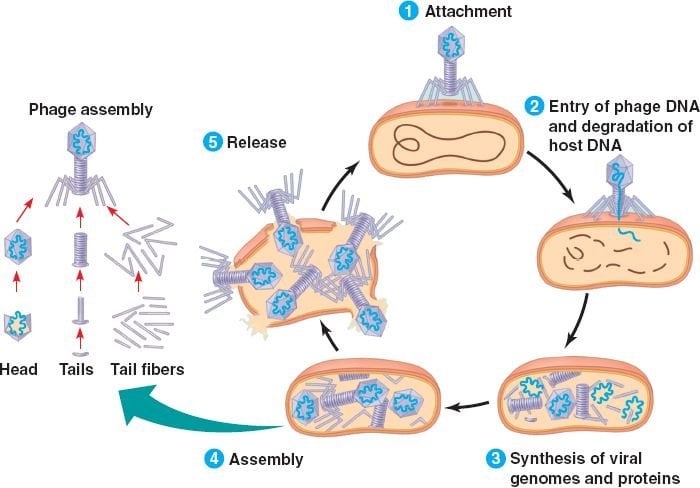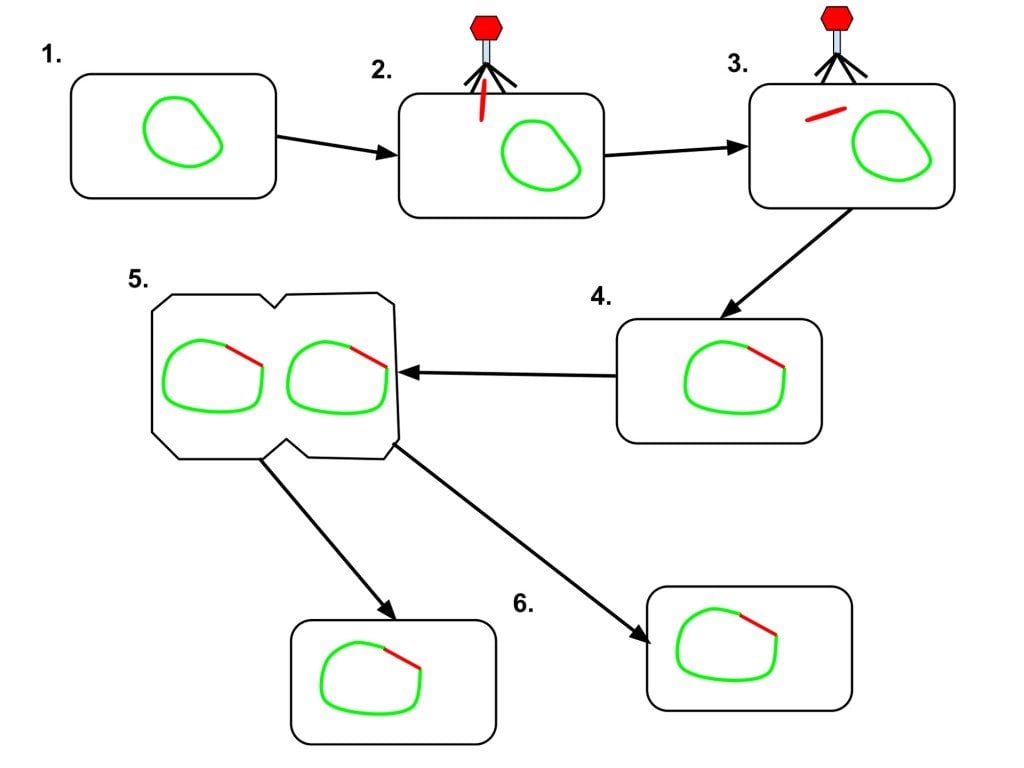Lytic And Lysogenic Cycle Difference
Viruses, once they infect a cell, accept two life wheel options bachelor. The lytic bike is their agile cycle, while the lysogenic bike is a dormant phase
Viruses are neither living nor dead. These fascinating creatures trip the light fantastic on border of these two states, actually. When they infect a host, they are considered to exist living, only without a host, they don't meet the bar to qualify as being "alive". Anything that is not living is dead, right? Or is it? This is simply one among a number of factors that makes for a very interesting written report of viruses. Another thing to consider is their life wheel. Humans have a constant, non-end cycle of birth, reproduction, and decease, as do most other organisms. Viruses, however, are slightly unlike, given that they tin halt their life cycle, and then to speak.
Recommended Video for you:
What Is The Lytic Cycle?
A virus, when it infects a host cell, has two possible life cycles through which it can motility. Depending on the ecology conditions and diverse other factors, it can determine which of them it wants to select – the lytic or lysogenic life cycle. A virus has 2 basic components – the viral DNA or RNA, and the protein coat. Some viruses, mainly animal viruses, also contain a lipid envelope. The start step for a virus is toattach to the outer membrane of the cell it wants to set on.
This can either exist done through the pores on the membrane surface, or sheer mechanical force. Post-obit this, itpenetrates the surface of the host and injects its ain genetic material into the cell. The adjacent stride is thetranscription of the viral DNA. This is the process of converting DNA to RNA using enzymes like RNA polymerase. Transcription is an important procedure, every bit it acts similar a preparatory step for the following process, which is essential. During transcription, the virus also destroys the host Deoxyribonucleic acid and takes over the full functioning of the prison cell.
After transcription is the biosynthesis phase. By this time, all of the cell's machinery is in the hands of the viral Dna. It then uses the host cell to individually manufacture or produce the diverse parts required to form a whole virus, which primarily includes copies of the DNA, the protein coat and the lipid envelope. Keep in mind that the virus is using the nutrients and other necessary substances of the host cell itself to further its own cause. The 2d to concluding step is thematuration process. During this fourth dimension, the virus orders the assembly of the various components to grade new viral cells, known as virions.

Lytic wheel (Photo Credit : Flickr)
Once a substantial number of virions have been produced and assembled, the virus causes the lysis of the host cell, and the newly formed virus particles are released into the surrounding intracellular temper, fully prepared to assault and enslave many other host cells. The whole process occurs at an impressive rate. The virus reaches the maturation phase within 30 minutes of initially attacking the host prison cell.
What Is The Lysogenic Cycle?
The lytic bicycle is known as the active bike, whereas the lysogenic wheel is the dormant phase of the virus. Similar to the lytic cycle, information technology begins with the attachment and penetration of the virus. Once the viral Deoxyribonucleic acid has been inserted into the cell, the host is now said to be infected. Here is where the main divergence between the two cycles occurs. In the lysogenic cycle, the viral DNA inserts itself, or incorporates itself into the host DNA, rather than staying separate, every bit is washed in the lytic stage. This is at present known as a prophage.
As office of the host DNA, the viral Dna as well replicates every time the host prison cell replicates. Another important point of difference is that the lytic phase results in the firsthand formation of multiple copies of the virus. Reverse to this, during the lysogenic bicycle, the viral DNA replicates only when the host cell does. Information technology spreads from the host to the daughter cells. Although this is a slower process, the viral DNA is safer, and so to speak, equally information technology can avert detection for longer periods of fourth dimension than it tin can in the lytic phase.

Lysogenic cycle (Photo Credit : Wikimedia Eatables)
The cosmos of multiple copies of the virus is done as the host cell divides itself and the phage DNA is passed on to the daughter cells. Withal, the viral Dna has the mechanism to catechumen from a lysogenic life wheel to a lytic cycle at any given point – a process known as induction.
Information technology usually occurs due to favorable weather, exposure to UV radiations, certain chemicals, etc. Viruses that tin just undergo the lytic bicycle are known equally virulent viruses, while those that tin undergo both the lytic and lysogenic cycles are known as temperate phages. Cells infected with temperate phages too have some advantages. Since the viral DNA combines with the bacterial Deoxyribonucleic acid, it likewise passes on certain genes and gives certain additional backdrop to the bacterial cell.
These bonus properties could increase the virulence of the leaner itself. In fact, some bacterial cells that are non-virulent have as well exhibited high levels of virulence when infected with certain phages.Bacillus anthracis cells, when infected with some phages, have the ability to form biofilms, a property that they don't normally possess.
Another benefit to the bacterial cells is that if they are infected by a virus, which then enters into the lysogenic stage, no other similar virus can attack the bacteria. Since the original virus is also in the dormant phase, the bacteria can go on functioning every bit normal. From a human being point of view, the lysogenic stage can be extremely dangerous, as the virus continues increasing in number inside the body, while the person would be completely asymptomatic and unaware of the growing threat!
Suggested Reading
-
Who We Are and How We Got Here: Ancient DNA and the new scientific discipline of the human being past -
The Immortal Life of Henrietta Lacks -
The Lawmaking Breaker: Jennifer Doudna, Cistron Editing, and the Future of the Human Race
Was this article helpful?
Aye No
Assistance us brand this article better
Lytic And Lysogenic Cycle Difference,
Source: https://www.scienceabc.com/pure-sciences/what-is-the-lytic-and-lysogenic-cycle.html
Posted by: hallashery1962.blogspot.com





0 Response to "Lytic And Lysogenic Cycle Difference"
Post a Comment